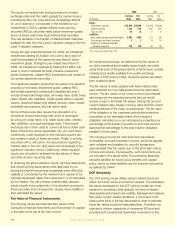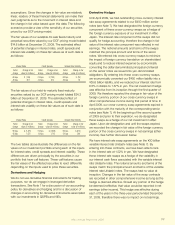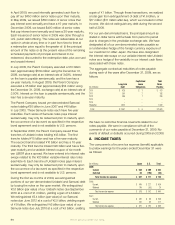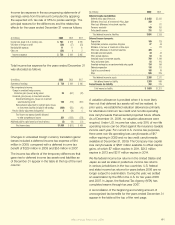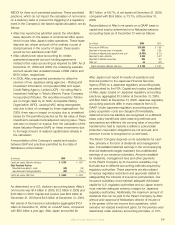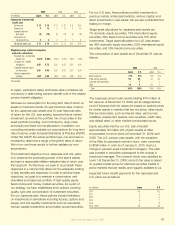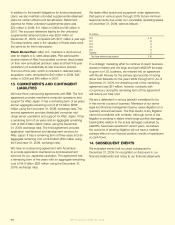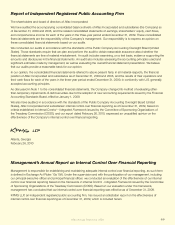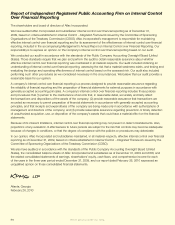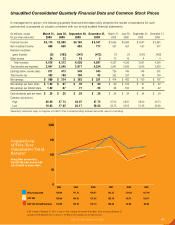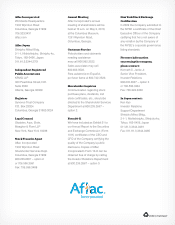Aflac 2009 Annual Report Download - page 89
Download and view the complete annual report
Please find page 89 of the 2009 Aflac annual report below. You can navigate through the pages in the report by either clicking on the pages listed below, or by using the keyword search tool below to find specific information within the annual report.
NEDOI for three such permitted practices. These permitted
practices, which do not impact the calculation of net income
on a statutory basis or prevent the triggering of a regulatory
event in the Company’s risk-based capital calculation, are as
follows:
• Aac has reported as admitted assets the refundable
lease deposits on the leases of commercial ofce space
which house Aac Japan’s sales operations. These lease
deposits are unique and part of the ordinary course of
doing business in the country of Japan; these assets
would be non-admitted under SAP.
• Aac utilizes book value accounting for certain
guaranteed separate account funding agreements
instead of fair value accounting as required by SAP. As of
December 31, 2009 and 2008, the underlying separate
account assets had unrealized losses of $98 million and
$150 million, respectively.
• In 2009, Aac was granted permission to utilize the
services of two Japanese rating agencies – Rating and
Investment Information, Incorporated (R&I) and Japan
Credit Rating Agency, Limited (JCR) – for rating Aac’s
investment holdings in Tohoku Electric Power Company
Incorporated (Tohoku). The securities issued by Tohoku
are no longer rated by an NAIC Acceptable Rating
Organization (ARO), causing NAIC rating downgrades
only due to lack of coverage by these organizations. For
2009, there was no impact on surplus due to unrealized
losses for this permitted practice as the fair value of these
investments exceeds book/adjusted carrying value. There
was also no impact on surplus from the calculation of the
Asset Valuation Reserve (AVR) on these investments due
to the large amount of realized capital losses already in
the calculation.
A reconciliation of the Company’s capital and surplus
between SAP and practices permitted by the state of
Nebraska is shown below:
(In millions) 2009 2008
Capital and surplus, Nebraska state basis $ 5,768 $ 4,601
State Permitted Practice:
Refundable lease deposits - Japan (46) (49)
Separate Account Funding Agreements (98) (150)
Capital and surplus, NAIC basis $ 5,624 $ 4,402
As determined on a U.S. statutory accounting basis, Aac’s
net income was $1.4 billion in 2009, $1.2 billion in 2008 and
$1.8 billion in 2007. Capital and surplus was $5.8 billion at
December 31, 2009 and $4.6 billion at December 31, 2008.
Net assets of the insurance subsidiaries aggregated $10.1
billion at December 31, 2009, on a GAAP basis, compared
with $8.0 billion a year ago. Aac Japan accounted for
$6.7 billion, or 66.7%, of net assets at December 31, 2009,
compared with $5.9 billion, or 73.7%, at December 31,
2008.
Reconciliations of Aac’s net assets on a GAAP basis to
capital and surplus determined on a Nebraska statutory
accounting basis as of December 31 were as follows:
(In millions) 2009 2008
Net assets on GAAP basis $ 10,086 $ 7,985
Adjustment of carrying values of investments 990 1,835
Elimination of deferred policy acquisition cost asset (8,395) (8,111)
Adjustment to policy liabilities 2,348 2,474
Adjustment to deferred income taxes 695 593
Other, net 44 (175)
Capital and surplus, Nebraska state basis $ 5,768 $ 4,601
Aac Japan must report its results of operations and
nancial position to the Japanese Financial Services
Agency (FSA) on a Japanese regulatory accounting basis
as prescribed by the FSA. Capital and surplus (unaudited)
of Aac Japan, based on Japanese regulatory accounting
practices, aggregated $1.9 billion at December 31, 2009,
and $2.0 billion at December 31, 2008. Japanese regulatory
accounting practices differ in many respects from U.S.
GAAP. Under Japanese regulatory accounting practices,
policy acquisition costs are charged off immediately;
deferred income tax liabilities are recognized on a different
basis; policy benet and claim reserving methods and
assumptions are different; the carrying value of securities
transferred to held to maturity is different; policyholder
protection corporation obligations are not accrued; and
premium income is recognized on a cash basis.
The Parent Company depends on its subsidiaries for cash
ow, primarily in the form of dividends and management
fees. Consolidated retained earnings in the accompanying
nancial statements largely represent the undistributed
earnings of our insurance subsidiary. Amounts available
for dividends, management fees and other payments
to the Parent Company by its insurance subsidiary may
uctuate due to different accounting methods required by
regulatory authorities. These payments are also subject
to various regulatory restrictions and approvals related to
safeguarding the interests of insurance policyholders. Our
insurance subsidiary must maintain adequate risk-based
capital for U.S. regulatory authorities and our Japan branch
must maintain adequate solvency margins for Japanese
regulatory authorities. Additionally, the maximum amount of
dividends that can be paid to the Parent Company by Aac
without prior approval of Nebraska’s director of insurance
is the greater of the net income from operations, which
excludes net realized investment gains, for the previous year
determined under statutory accounting principles, or 10%
Aflac Annual Report for 2009 85



